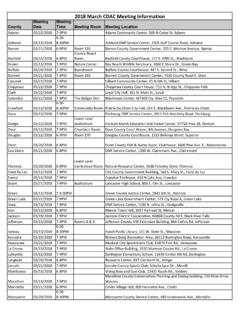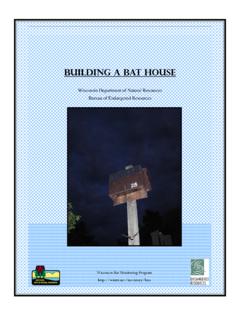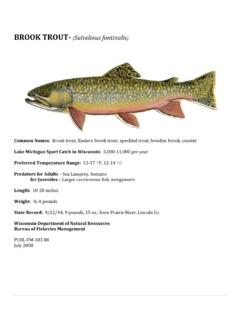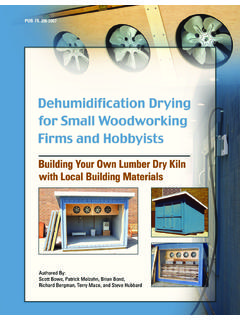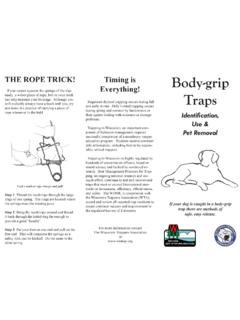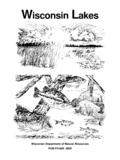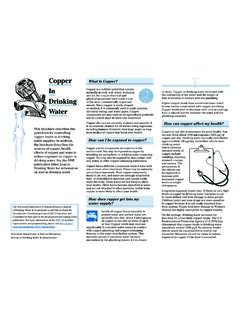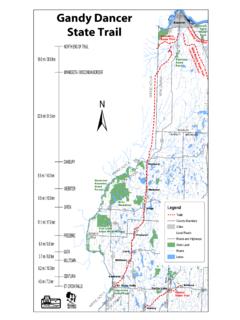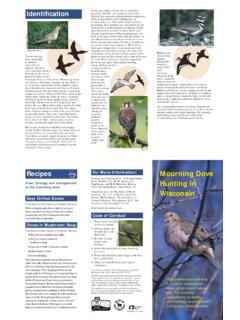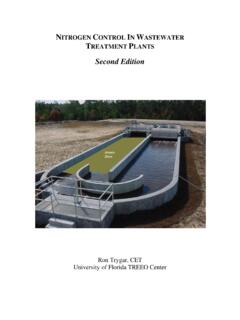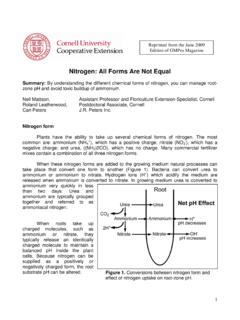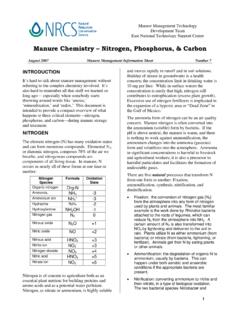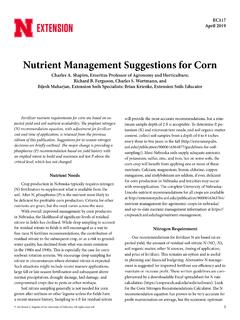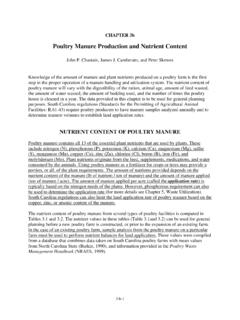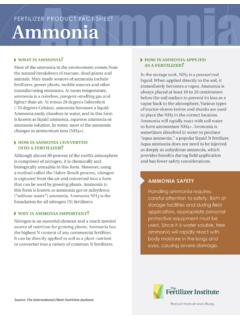Transcription of Nutrient Removal - Total Nitrogen Study Guide
1 Printed on 10/08/18 Nutrient Removal - Total Nitrogen Study GuideOctober 2018 Edition Wisconsin Department of Natural Resources Bureau of Science Services, Operator Certification Program Box 7921, Madison, WI 53707 NWisconsin Department of Natural ResourcesThe Wisconsin Department of Natural Resources provides equal opportunity in its employment, programs, services, and functions under anAffirmative Action Plan. If you have any questions, please write to Equal Opportunity Office, Department of Interior, Washington, publication is available in alternative format (large print, Braille, audio tape. etc.) upon request. Please call (608) 266-0531 for Operator CertificationPrinted on 10/08/18 PrefaceThe Nutrient Removal - Total Nitrogen Study Guide is an important resource for preparing for the certification exam and is arranged by chapters and sections.
2 Each section consists of key knowledges with important informational concepts needed to know for the certification exam. This Study Guide also serves as a wastewater treatment plant operations primer that can be used as a reference on the subject. Any diagrams, pictures, or references included in this Study Guide are included for informational/educational purposes and do not constitute endorsement of any sources by the Wisconsin Department of Natural Resources. Preparing for the exams: 1. Study the material! Read every key knowledge until the concept is fully understood and known to memory. 2. Learn with others! Take classes in this type of wastewater operations to improve understanding and knowledge of the subject.
3 3. Learn even more! For an even greater understanding and knowledge of the subjects, read and review the references listed at the end of the Study Guide . Knowledge of the Study Guide material will be tested using a multiple choice format. Every testquestion and answer comes directly from one of the key knowledges. Choosing a test date: Before choosing a test date, consider the time needed to thoroughly Study the guides and the training opportunities available. A listing of wastewater training opportunities and exam dates is available at by searching for the keywords Operator Certification .AcknowledgementsThe Nutrient Removal - Total Nitrogen Study Guide was the result of a collaborative effort of yearlong monthly meetings of wastewater operators, trainers, consultants, the Wisconsin Wastewater Operator Association (WWOA), and the Wisconsin Department of Natural Resources (WDNR).
4 This Study Guide was developed as the result of the knowledge and collective work of following workgroup members: Greg Paul, Op2 Myz, La Crosse, WI Paul McGinely, University of Wisconsin-Stevens Point, Stevens Point, WI Gary Hanson, Short Elliott Hendrickson, Inc, Delafield, WI Dan Tomaro, Wastewater Training Solutions, Oregon, WI Barti Oumarou, Wisconsin Department of Natural Resources, Oshkosh, WI Danielle Luke, Wisconsin Department of Natural Resources, Madison, WI Jack Saltes, Wisconsin Department of Natural Resources, Madison, WINutrient Removal - Total Nitrogen Study Guide - Subclass NPrinted on 10/08/18 Chapter 1 - Theory and PrinciplesChapter 2 - Operations and MaintenanceChapter 3 - Monitoring, Process Control.
5 And TroubleshootingChapter 4 - SafetyChapter 5 - CalculationsSection - DefinitionsSection - Wastewater CharacteristicsSection - Biological PrinciplesSection - Reactors and MethodsSection - Performance Limiting FactorsSection - Sampling and TestingSection - Data Understanding and InterpretationSection - Corrective ActionsSection - DefinitionsSection - SafetySection - Sludge AgeSection - Hydraulic Retention TimeTable of ContentsNutrient Removal - Total Nitrogen Study Guide - Subclass Npg. 1pg. 3pg. 4pg. 5pg. 8pg. 9pg. 11pg. 11pg. 12pg. 12pg. 13pg. 13 Printed on 10/08/18 Page 1 of 18 Chapter 1 - Theory and PrinciplesSection - DefinitionsAerobic is a condition in which free and dissolved oxygen (DO) is available in an aqueous is the ability of the wastewater to neutralize acid without effect on the pH and ismeasured as the calcium carbonate equivalent in Ammonia (NH3)Ammonia is a form of Nitrogen that exists in aquatic environments and is toxic to fish andother aquatic organisms.
6 The WPDES Permit limits for ammonia are calculated based on: stream flow, stream temperature, stream pH, and the type of fishery classification. Ammonia is tested and reported as ammonia- Nitrogen (mg/L).B. Nitrate (NO3-)Nitrate is the predominant form of Nitrogen in groundwater. It has a Wisconsin Groundwater Enforcement Standard (ES) of 10 mg/L as nitrate- Nitrogen (NO3-N). This standard is based on the risk of methemoglobinemia (blue-baby syndrome) in infants less than six months of age. Nitrate is tested and reported as nitrate- Nitrogen (mg/L).C. Nitrite (NO2-)Nitrite is an intermediate product when ammonium is nitrified into nitrate and as nitrate denitrifies to Nitrogen gas.
7 Nitrite levels are higher in plant effluents with partial nitrification or denitrification occurring. Nitrite is tested and reported as nitrite- Nitrogen (mg/L).D. Organic Nitrogen (Org-N)Organic Nitrogen is Nitrogen bonded with carbon and is found in proteins, amino acids, urea, living or dead organisms, and decaying plant Total Nitrogen (TN) Total Nitrogen is the sum of nitrate, nitrite, ammonia, and organic Nitrogen . It is commonpractice to include a 10 mg/L of Total Nitrogen limitation in WPDES permits for groundwater discharges to ensure that drinking water standards are maintained in water is a condition in which free, dissolved, and combined oxygen is unavailable in an aqueous is a condition in which oxygen is only available in combined form such as nitrate aerobic (oxic) [O2].
8 Define the different forms of Nitrogen in wastewater, their limits, and the reasons for theirlimits in Wisconsin Pollutant Discharge Elimination System (WPDES) anaerobic [ ].Define anoxic [NO2, NO3, SO4]. Nutrient Removal - Total Nitrogen Study Guide - Subclass NPrinted on 10/08/18 Page 2 of 18 (NO3-), nitrite (NO2-), or sulfate (SO4) in an aqueous is the biological reduction of Nitrogen and/or phosphorus in the final effluent using microorganisms.(Standard Method 5210B) The cBOD test is used to measure the oxygen demand of carbonaceous organic material in a wastewater sample as cBOD (mg/L). This test includes the use of a nitrogenous demand inhibitor to exclude the oxygen demand of ammonia and organic is a biological process where bacteria convert nitrate (NO3-) to Nitrogen gas (N2) under anoxic are bacteria that convert nitrate to Nitrogen gas in an anoxic is the excessive growth of plant and algae in receiving waters due to dissolved nutrients and their , also known as detention time, is the period of time that wastewater remains in a is depressed oxygen levels below the mg/L necessary to sustain most aquatic life.
9 Hypoxia can result from is the most widespread groundwater contaminant in Wisconsin. It has a federal Maximum Contaminant Level (MCL) and Wisconsin Groundwater Enforcement Standard(ES) of 10 mg/L as nitrate- Nitrogen . The standards are based on the risk of methemoglobinemia (Blue Baby Syndrome) in infants under six months of is a biological process where nitrifiers convert Nitrogen in the form of ammonia (NH3) into nitrite (NO2-) and then nitrate (NO3-) under aerobic are bacteria that convert ammonia into nitrite then nitrate in an aerobic biological Nutrient Removal (BNR).Define carbonaceous biochemical oxygen demand (cBOD).Define hydraulic retention time (HRT).
10 Define the Nitrate Groundwater nitrogenous oxygen demand (NOD). Nutrient Removal - Total Nitrogen Study Guide - Subclass NPrinted on 10/08/18 Page 3 of 18 Section - Wastewater CharacteristicsNOD is the amount of oxygen required to convert ammonia to nitrite then nitrate in a sample and is measured in selector is part of the treatment system that selects for a specific type of microorganism by providing an environment (anaerobic, anoxic, aerobic) that favors its age is the theoretical length of time a particle of activated sludge stays in the treatment plant and is measured in days. In an activated sludge plant, sludge age is the amount (lbs) of mixed liquor suspended solids (MLSS) divided by the suspended solids, or excess cell mass, withdrawn from the system per day (lbs/day of waste activated sludge (WAS)).

